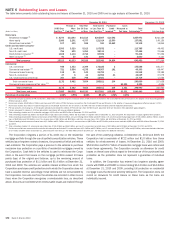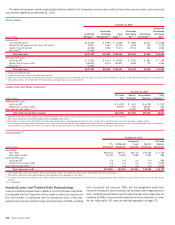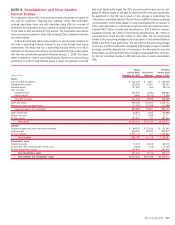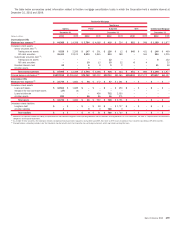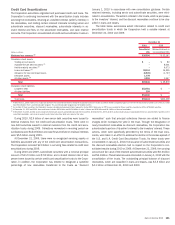Bank of America 2010 Annual Report Download - page 182
Download and view the complete annual report
Please find page 182 of the 2010 Bank of America annual report below. You can navigate through the pages in the report by either clicking on the pages listed below, or by using the keyword search tool below to find specific information within the annual report.
Home Equity Mortgages
The Corporation maintains interests in home equity securitization trusts to
which the Corporation transferred home equity loans. These retained inter-
ests include senior and subordinate securities and residual interests. In
addition, the Corporation may be obligated to provide subordinate funding to
the trusts during a rapid amortization event. The Corporation also services the
loans in the trusts. Except as described below and in Note 9 – Representa-
tions and Warranties Obligations and Corporate Guarantees, the Corporation
does not provide guarantees or recourse to the securitization trusts other
than standard representations and warranties. There were no securitizations
of home equity loans during 2010 and 2009. Collections reinvested in
revolving period securitizations were $21 million and $177 million during
2010 and 2009. Cash flows received on residual interests were $12 million
and $35 million in 2010 and 2009.
The table below summarizes select information related to home equity
loan securitization trusts in which the Corporation held a variable interest at
December 31, 2010 and 2009.
(Dollars in millions)
Consolidated
VIEs
Retained
Interests in
Unconsolidated
VIEs Total
Retained
Interests in
Unconsolidated
VIEs
2010 2009
December 31
Maximum loss exposure
(1)
$3,192 $ 9,132 $12,324
$13,947
On-balance sheet assets
Trading account assets
(2, 3)
$ – $209$209
$16
Available-for-sale debt securities
(3, 4)
–3535
147
Loans and leases
3,529 – 3,529
–
Allowance for loan and lease losses
(337) – (337)
–
Total
$3,192 $ 244 $ 3,436
$163
On-balance sheet liabilities
Long-term debt
$3,635 $ – $ 3,635
$–
All other liabilities
23 – 23
–
Total
$3,658 $ – $ 3,658
$–
Principal balance outstanding
$3,529 $20,095 $23,624
$31,869
(1)
For unconsolidated VIEs, the maximum loss exposure includes outstanding trust certificates issued by trusts in rapid amortization, net of recorded reserves, and excludes the liability for representations and warranties and corporate
guarantees.
(2)
At December 31, 2010 and 2009, $204 million and $15 million of the debt securities classified as trading account assets were senior securities and $5 million and $1 million were subordinate securities.
(3)
As a holder of these securities, the Corporation receives scheduled principal and interest payments. During 2010 and 2009, there were no OTTI losses recorded on those securities classified as AFS debt securities.
(4)
At December 31, 2010 and 2009, $35 million and $47 million represent subordinate debt securities held. At December 31, 2009, $100 million are residual interests classified as AFS debt securities.
Under the terms of the Corporation’s home equity loan securitizations,
advances are made to borrowers when they draw on their lines of credit and
the Corporation is reimbursed for those advances from the cash flows in the
securitization. During the revolving period of the securitization, this reimburse-
ment normally occurs within a short period after the advance. However, when
certain securitization transactions have begun a rapid amortization period,
reimbursement of the Corporation’s advance occurs only after other parties in
the securitization have received all of the cash flows to which they are entitled.
This has the effect of extending the time period for which the Corporation’s
advances are outstanding. In addition, if loan losses requiring draws on
monoline insurers’ policies, which protect the bondholders in the securitiza-
tion, exceed a specified threshold or duration, the Corporation may not receive
reimbursement for all of the funds advanced to borrowers, as the senior
bondholders and the monoline insurers have priority for repayment.
Substantially all of the home equity loan securitizations for which the
Corporation has an obligation to provide subordinate advances have entered
rapid amortization. The Corporation evaluates each of these securitizations
for potential losses due to non-recoverable advances by estimating the
amount and timing of future losses on the underlying loans, the excess
spread available to cover such losses and potential cash flow shortfalls during
rapid amortization. A maximum funding obligation attributable to rapid
amortization cannot be calculated as a home equity borrower has the ability
to pay down and re-draw balances. At December 31, 2010 and 2009, home
equity loan securitization transactions in rapid amortization, including both
consolidated and unconsolidated trusts, had $12.5 billion and $14.1 billion
of trust certificates outstanding. This amount is significantly greater than the
amount the Corporation expects to fund. At December 31, 2010, the remain-
ing $93 million of trust certificates outstanding related to these types of
securitization transactions are expected to enter rapid amortization during the
next 12 months. The charges that will ultimately be recorded as a result of the
rapid amortization events depend on the performance of the loans, the
amount of subsequent draws and the timing of related cash flows. At De-
cember 31, 2010 and 2009, the reserve for losses on expected future draw
obligations on the home equity loan securitizations in or expected to be in
rapid amortization was $131 million and $178 million.
The Corporation has consumer MSRs from the sale or securitization of
home equity loans. The Corporation recorded $79 million and $128 million of
servicing fee income related to home equity securitizations during 2010 and
2009. The Corporation repurchased $17 million and $31 million of loans from
home equity securitization trusts in order to perform modifications or pursu-
ant to clean up calls during 2010 and 2009.
180 Bank of America 2010


